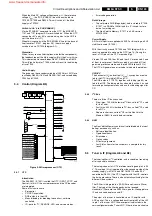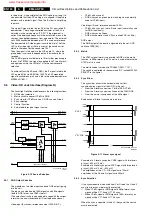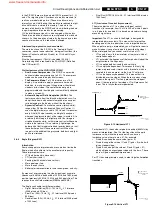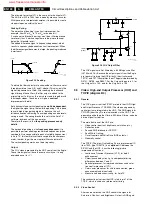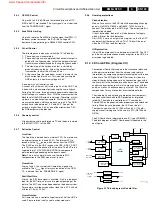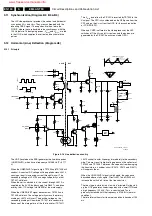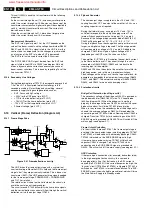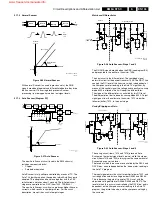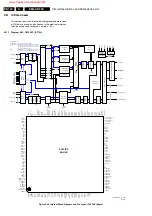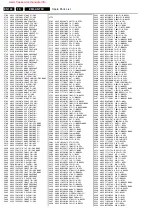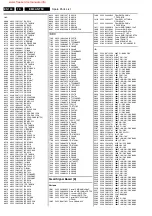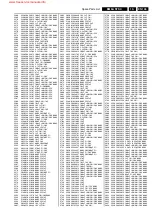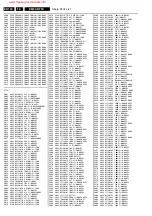
Circuit Descriptions and Abbreviation List
9.
9.14 Audio (Diagram B6, B10, and A6)
9.14.1 Introduction
The EM5 chassis contains ITT's Multi-standard Sound
Processing (MSP IC, type MSP34x2) for sound decoding.
The MSP IC takes care of the main FM sound decoding.
The MSP contain digital audio processing, used for the basic
left/right stereo sound, such as bass, treble, balance, incredible
sound and spatial.
Additionally, the MSP34x2 can perform 'Dolby ProLogic'
processing (left, right and (mono) surround.)
Figure 9-22 Dolby Pro Logic processing
The following amplifier configuration is used:
•
3D Surround, L/R, Center, Subwoofer, 4 x 15 W (95XX-
series.)
9.14.2 Inputs / Outputs
The MSP can cover four stereo inputs and one mono input.
Outputs: CVBS/decoder out, record select/WYSIWYR (What
You See Is What You Record) and headphone.
9.14.3 Audio Decoding
At the input, a choice can be made between two IF-signals; SIF
and SIFM.
The selected signal is fed to the AGC. After this, an ADC
converts the IF-signal to digital.
Two demodulation channels can process this digital signal. The
first one is able to handle FM and NICAM signals. The second
one can handle FM and AM signals.
Each channel contains a mixer to shift the incoming signal in
the frequency domain. This shift is determined by the value of
a DCO.
After the down-mix, the signal is fed, via a filter, to a
discriminator. From here the AM, FM or NICAM demodulation
can be performed.
Both channels contain an 'automatic carrier mute' function,
which automatically mutes the output of the analog section
when no carrier is detected.
After demodulation, the FM-signals are subjected to a de-
emphasis operation. After that, the matrix of the stereo system
is applied.
9.14.4 Audio Processing
The sound processing is performed completely by the MSP:
•
Volume control is performed by the user via the SOUND
menu.
•
Tone control in 'Stereo' sets is performed via the BASS/
TREBLE control.
•
Headphone control: the MSP has a separate Headphone
output so separate sound control is possible.
Automatic Volume Leveling (AVL)
One of the features of the MSP-family is Automatic Volume
Limiting (AVL.) If used, it limits large volume differences in the
broadcast between television programs and commercials, or
within a movie.
The AVL feature is controlled by the customer through the
menu.
9.14.5 Audio Amplifier (Diagram A6)
The audio amplifier is an integrated 'class-D' power amplifier
IC, the TDA7490. It delivers an output of 2 x 15 W
RMS
to two full
range speakers. For the higher specified sets, a subwoofer and
center speaker are easy to implement, by adding a second
amplifier.
Principle
Audio-power-amplifier systems have traditionally used linear
amplifiers, which are well known for being inefficient. In fact, a
linear Class AB amplifier is designed to act as a variable
resistor network between the power supply and the load. The
transistors operate in their linear region, and the voltage that is
dropped across the transistors (in their role as variable
resistors) is lost as heat, particularly in the output transistors.
Class D amplifiers were developed as a way to increase the
efficiency of audio-power-amplifier systems.
Figure 9-23 Principle Class-D Amplifier
The Class D amplifier works by varying the duty cycle of a
Pulse Width Modulated (PWM) signal.
By comparing the input voltage to a triangle wave, the amplifier
increases duty cycle to increase output voltage, and decreases
duty cycle to decrease output voltage.
The output transistors of a Class D amplifier switch from full 'off'
to full 'on' (saturated) and then back again, spending very little
time in the linear region in between. Therefore, very little power
is lost to heat.
If the transistors have a low 'on' resistance R
DS(ON)
, little voltage
is dropped across them, further reducing losses.
The advantage of Class D is increased efficiency (less heat
dissipation.) Class D amplifiers can drive the same output
power as a Class AB amplifier using less supply current.
The disadvantage is the large output filter that drives up cost
and size. The main reason for this filter is that the switching
waveform results in maximum current flow. This causes more
loss in the load, which causes lower efficiency.
An LC filter with a cut-off frequency less than the Class D
switching frequency (200 kHz), allows the switching current to
flow through the filter instead of the load. The filter is less lossy
than the speaker, which causes less power dissipated at high
output power and increases efficiency in most cases.
MONO-IN
7651
CENTER
SCART 2
SCART 1 / decoder out
Constant Level
Variable Level
DACA_L/R
DACM_L/R
D_CTR_I/O_0
SC1-OUT
SC1-IN
MICRONAS
MSP3412G
SC2-IN
SC3-IN
TUNER L/R
28/29
CL L/R
25/26
7653
17/18
24
DACM_L/R
DACM_SUB
DACM_C
SC2-OUT
23
22
"Set is center"
20/21
SC4-IN
EXT1 L/R
EXT2 L/R
FRONT L/R
EXT3 L/R
44/45
50
47
41/42
38/39
35/36
CL 16532044_029.eps
140501
MAIN IF
HIP
7702
74HC4053
2 times
74HC4053
SEL_IN_2
7652
Surround cinch
or Phone plug
MAIN
7700
SUB
WOOFER
7702
HEADPHONE
7770
7652
74HC4053
CL16532099_002.eps
200801
+V
-V
www.freeservicemanuals.info
Summary of Contents for EM5A NTSC
Page 6: ...Direction for Use EN 6 EM5A NTSC 3 3 Direction for Use www freeservicemanuals info ...
Page 7: ...Direction for Use EN 7 EM5A NTSC 3 www freeservicemanuals info ...
Page 8: ...Direction for Use EN 8 EM5A NTSC 3 www freeservicemanuals info ...
Page 9: ...Direction for Use EN 9 EM5A NTSC 3 www freeservicemanuals info ...
Page 10: ...Direction for Use EN 10 EM5A NTSC 3 www freeservicemanuals info ...
Page 11: ...Direction for Use EN 11 EM5A NTSC 3 www freeservicemanuals info ...
Page 12: ...Direction for Use EN 12 EM5A NTSC 3 www freeservicemanuals info ...
Page 13: ...Direction for Use EN 13 EM5A NTSC 3 www freeservicemanuals info ...
Page 14: ...Direction for Use EN 14 EM5A NTSC 3 www freeservicemanuals info ...
Page 15: ...Direction for Use EN 15 EM5A NTSC 3 www freeservicemanuals info ...
Page 16: ...Direction for Use EN 16 EM5A NTSC 3 www freeservicemanuals info ...





